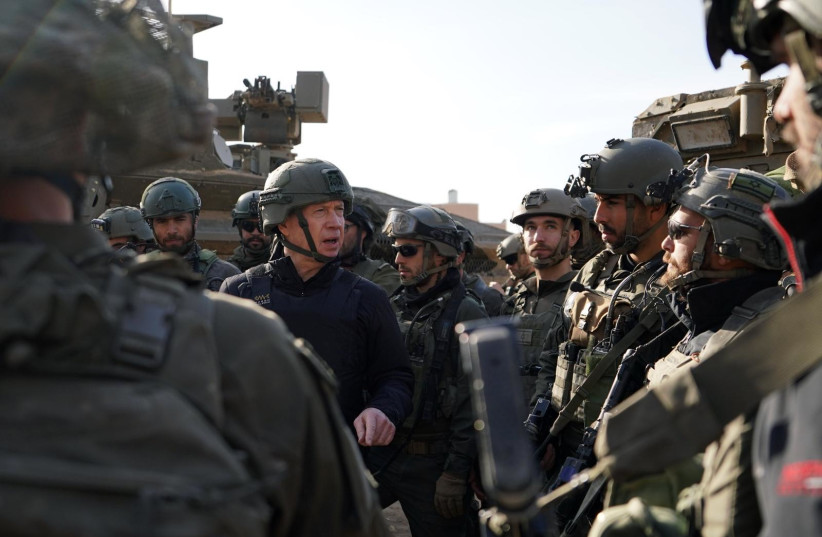Hezbollah fired a barrage of rockets at cities and towns all over northern Israel on Sunday, leading to the sounding of 33 air raid alerts, the most in the recent period.
In Gaza, meanwhile, the IDF took over Hamas’s Khan Yunis brigade headwaters and announced the death of a soldier, Sgt.-Maj. (res.) Shimon Yehoshua Asulin was killed in battle in southern Gaza.
At midday, IDF aircraft struck Hezbollah positions, targeting infrastructure such as rocket launchers and observation posts in Blida and Meis el-Jabal in southern Lebanon. Rockets from Lebanon were identified approaching the Israeli border, triggering rocket alarms in northern Israeli communities, including Kiryat Shmona, Manara, Margaliot, and Metulla.
As the day progressed, more communities were also fired at, with no casualties in Israel, most of whose 80,000 residents had evacuated back in October.
IDF still has the upper hand
Despite Hezbollah’s salvo of rockets on Sunday, Defense Minister Yoav Gallant said during a visit to the Tel Nof Air Base that the IDF was gaining the upper hand in pushing Hezbollah’s ground forces back to the Litani River.

Gallant said that the IDF’s growing successes were making it less likely that a full-scale war would be needed to regain security on the northern border.
Already to date, the IDF has pushed back 75% of the elite Radwan forces to the Litani River and destroyed 85-95% of Hezbollah’s lookout posts in southern Lebanon.
Still, Hezbollah started the war with approximately 150,000 rockets and mortars, more than 95% of which it still has, and it has not yet given any indication that it would permanently keep its forces north of the Litani.
In southern Gaza, the IDF took control of the Hamas Khan Yunis brigade headquarters, used by Muhammad Sinwar, brother and top lieutenant to Gaza Chief Yahya Sinwar. On December 17, the military said it took over Hamas’s City Hall and another office of its brigade chief, Rafa’a Salame.
IDF sources said that the headquarters was the largest they had seen in Khan Yunis. They added that they expected to achieve operational control in Khan Yunis within one week, the smallest amount of time the IDF has given yet for this benchmark.
Last week, Gallant said that all of Hamas’s four battalions in Khan Yunis were taken apart, seemingly ahead of the military’s schedule. IDF sources clarified to The Jerusalem Post that he must have meant that the process of taking apart the battalions was so far along – even if not complete – that their elimination was close to inevitable and would occur very soon.
Even after operational control is achieved, as in northern Gaza, IDF sources acknowledged that there will still be fighting against smaller remaining terrorist cells.
The general idea is that more of the fighting will be against these smaller groups, which are cut off from the greater Hamas collective command structure, as opposed to the fighting until now, where Hamas often had hundreds of fighters resisting the IDF in coordination.
IDF success in Khan Yunis
The Givati brigade had killed 550 Hamas terrorists on the ground, with another 250 using air support. On Sunday, Hamas numbers were already lower – 14 killed by the IDF.
Some 120,000 Palestinians were evacuated by the IDF in Khan Yunis over five days to clear the area. The IDF also arrested and sent for interrogation some 500 Hamas fighters, which it said led to significant intelligence gains.
Although IDF sources said they found many signs in Khan Yunis of Hamas’s leadership and the Israeli hostages they are holding captive, there was no concrete discussion of being able to find them imminently. Taking operational control of Khan Yunis without finding them has increased the probability that they are hiding in Rafah.
Israel still has not yet solidified the terms with Egypt for entering Rafah to search what has ballooned to four Hamas battalions among at least 1.5 million civilians.
On Sunday, the IDF announced that Sgt.-Maj. (res.) Shimon Yehoshua Asulin was killed in a battle in southern Gaza. He was drafted already on October 7.
Asulin served in a combat engineering unit. His father, Rafi, told KAN that he was released after around 75 days but “had a hard time believing he was out [of Gaza] and not in. He was restless, and he had friends that were in.”
Last Wednesday, he was called to a unit in southern Gaza. “We raised this generation to believe that if they don’t do the job, no one will. This generation is doing the job,” Rafi said. He recalled that the last communication he and his wife had with his son was a phone call on Friday before Shabbat. They received the news on Saturday night, and he was subsequently buried in Jerusalem’s Mount Herzl Military Cemetery on Sunday.
As to where the war is going next, Israeli officials said on Sunday that the military would coordinate with Egypt, seeking ways to evacuate civilians back north to free up Rafah.
A UN office on Friday expressed concern about hostilities in Khan Yunis forcing more people into Rafah as well as what would happen if the war moves to Rafah, which is a “pressure cooker of despair.”
Despite the concerns, IDF sources have indicated that no operation in Rafah is imminent.
Jerusalem Post Staff and Reuters contributed to this report.
